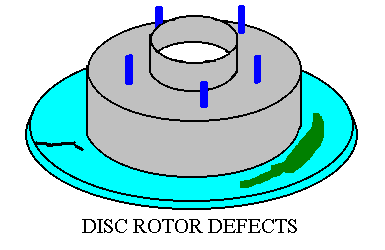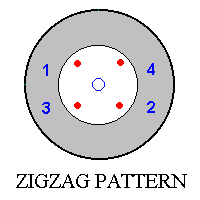Inspecting Your Disc Brakes
*HARD*
You should inspect your disc brakes every six months or 5,000 miles. It is advantageous to coincide the disc brake inspection with the tire rotation since the tires have to removed to inspect the brakes. They may as well be rotated after the brake inspection. Use the following procedure to examine your disc brakes:
- Park the vehicle on level ground with the engine OFF, the parking brake engaged, and the transmission in PARK (for automatic) or REVERSE (for manual). Allow the brakes to cool if your car has been driven recently, since the temperature of brake pads may reach as high as 500° F.
- Loosen the lug nuts on both front wheels with a tire iron. Elevate the vehicle front end on safety stands and block the rear wheels. Clean any dirt or rust from the lug bolts (studs). Remove the lug nuts from the studs and both front wheels from the vehicle.
- Inspect the inside and outside surfaces of the left and right disc rotors
for scratches, cracks, burns, corrosion, or unevenness. If any of these defects
is found, the brakes need servicing.
Generally, if rotor defects are superficial, they can be removed by resurfacing the rotor. This process removes metal from the rotor surface but cannot be used to remove deep cracks or gouges; rotors must be replaced when defects are substantial. If the rotors are machined too thin, they will build up heat and warp. Be sure to rotate the rotor by hand to examine the entire surface. If the rotor resists rotation, a caliper piston inside might be seized. In this case, a new caliper assembly will be required. A professional automotive technician can help you decide whether to resurface or replace a rotor. - Examine the condition of the calipers; they should be dirt-free. Look for brake fluid or shock absorber fluid leaks around the calipers. Have any leaks repaired immediately.
- Look through the caliper viewing hole or inspection window and observe the
inboard and/or
outboard pad wear from the side.
Be sure the brake pads have
sufficient thickness; they should be at least as thick as the metal shoe to
which they are attached. Pads should be a minimum of 1/16" thick, or about
as thick as a nickel, if they are glued to brake shoe. If the pads are riveted
to the shoe, their surfaces should be at least 1/16" above the rivet heads.
If the pads are too thin, replace them.
Pads must be replaced in sets of four, that is, inner and outer pads for both left and right wheels. Do not replace the pads individually. The viewing hole is most relevant to bonded pads since rivets cannot be seen from the hole. - If brake pad thickness varies more than 1/8" between opposite ends, or if pads are contaminated with brake fluid, replace the pad and shoe assemblies as well. However, correct the cause of the problem first. If the inner and outer pads are wearing at different rates, the caliper is faulty and must be repaired.
- Remount both front wheels. Tighten the lug nuts on each wheel by hand in
an even, but alternating zigzag pattern.
Lower the car to the ground enough for the tire tread to make contact. Finish tightening the lug nuts to the correct specification. Remove the safety stands and wheel blocks. - If your vehicle has all disc brakes, repeat the inspection procedure for the rear brakes as well.
The integrity of the brake system is important to the control of the vehicle and safety of its occupants. Repair of the disc brake caliper requires special tools and skill and should therefore only be performed by a professional automotive technician.


